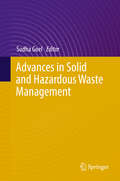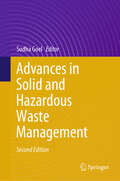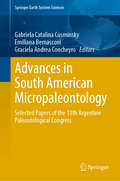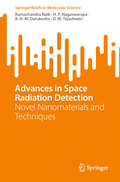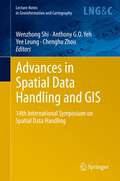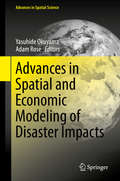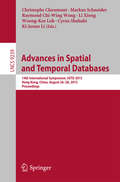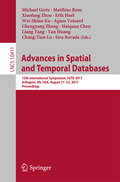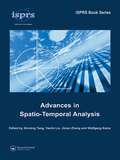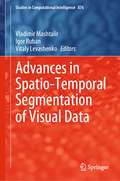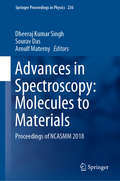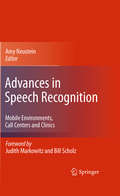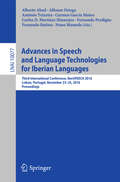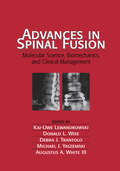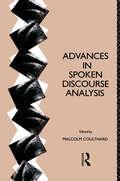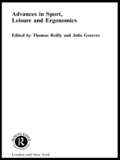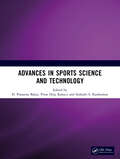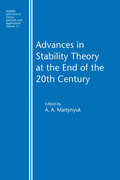- Table View
- List View
Advances in Solid Oxide Fuel Cells and Electronic Ceramics
by Narottam P. Bansal Soshu Kirihara Jingyang Wang Mihails Kusnezoff Kiyoshi ShimamuraThis book is a collection of papers from The American Ceramic Society's 35th International Conference on Advanced Ceramics and Composites, held in Daytona Beach, Florida, January 23-28, 2011. This issue includes papers presented in the 8th International Symposium on Solid Oxide Fuel Cells: Materials, Science, and Technology on topics such as Cell and Stack Development; Electrochemical/Mechanical/Thermal Performance; Electrodes; Interconnects; Novel Cell/Stack Design and Processing; and Reliability/Degradation.
Advances in Solid Oxide Fuel Cells and Electronic Ceramics II
by Narottam P. Bansal Mihails Kusnezoff Kiyoshi Shimamura Manabu Fukushima Andrew GyekenyesiThis issue contains 13 papers from The American Ceramic Society’s 40th International Conference on Advanced Ceramics and Composites, held in Daytona Beach, Florida, January 24-29, 2016 presented in Symposium 3 - 13th International Symposium on Solid Oxide Fuel Cells: Materials, Science, and Technology and Symposium 14 – Single Crystalline Materials for Electrical, Optical, and Medical Applications.
Advances in Solid and Hazardous Waste Management
by Sudha GoelThis book presents reviews, examples and case studies of innovative applications in solid and hazardous waste management. The economics of waste management have since become a significant research area in their own right, and two chapters address these issues. In addition, dedicated chapters cover specific categories of waste such as biomedical and institutional waste, plastics and e-waste. The book subsequently discusses newer analytical methods like SEM, EDX, XRD and optical microscopy, along with selected "older" methods for sampling and characterizing different types of waste. The various applications of mathematical tools like linear optimization, various software/models like WISCLeach, and DRASTIC, and tools like remote sensing and GIS are illustrated in many of the chapters. Lastly, since composting is one of the most popular treatment methods for managing the organic component of municipal solid waste, the book provides an overview of composting and the fundamentals of microbiology that are essential to understanding waste-related biological processes. The book was primarily written for students and practitioners in the field who are already familiar with the basics. All chapters were prepared by practicing experts and scholars in the field, and are intended to help readers better understand and apply these principles and practices in their own endeavours. Key topics covered in the book: * The circular economy and the economics of solid waste management * Various remote sensing and GIS applications for managing municipal solid waste, coal fires in mines, changes in land use and land cover in industrial areas, etc. * Treatment and management of different types of solid waste: institutional (including biomedical), residential, e-waste, plastic, and ash from thermal power plants * Sampling and characterization of municipal waste and compost * Fundamentals of microbiology * Overview of environmental regulations, especially those pertaining to solid and hazardous waste management
Advances in Solid and Hazardous Waste Management
by Sudha GoelThis book provides the reader with topical applications of innovative tools for better solid and hazardous waste management. Separate sections have been compiled for both traditional and new solid waste categories with examples and case studies in all of them. Various physical, chemical and biological processes can be used for segregation and treatment of these wastes and some advanced methods are covered in this book. Advances in laboratory analytical methods, mathematical tools, remote sensing and GIS have been successfully applied to finding solutions to many problems in this field.
Advances in Solid-State Welding and Processing of Metallic Materials
by R. Vaira Vignesh R. Padmanaban M. GovindarajuThis book covers the essential information needed to understand the latest developments of solid-state welding and processing of metallic materials, including physical metallurgy, production technologies, alloy development, compositing, post-processing, and joining methodologies.Advances in Solid-State Welding and Processing of Metallic Materials is the result of the collaborative efforts from expert researchers across various institutions around the globe. Harnessing this wealth of expertise and experience, the book enables the reader to comprehend both the theory behind microstructural evolution, as well as the practical elements of welding and processing. It also analyzes strengthening mechanisms, corrosion mechanisms, and wear mechanisms. Topics discussed in this book include friction stir welding, friction stir processing, modified friction stir clinching, hot-rolling and cold-rolling alongside diffusion bonding, and powder metallurgy processing. This book is a valuable companion to all students and researchers in metallurgy, materials science and engineering, manufacturing engineering, and production engineering.
Advances in South American Micropaleontology: Selected Papers of the 11th Argentine Paleontological Congress (Springer Earth System Sciences)
by Gabriela Catalina Cusminsky Emiliana Bernasconi Graciela Andrea ConcheyroThis book offers many examples of calcareous microfossils and describes a new microfaunistic record in Argentina. These selected papers of the 11th Argentine Paleontological Congress include micropaleontological studies on material of different geological ages from several sites in Argentina and Colombia. The authors highlight several geological findings and explain the paleoenvironmental changes in Argentina and Colombia.
Advances in Space Radiation Detection: Novel Nanomaterials and Techniques (SpringerBriefs in Molecular Science)
by H. P. Nagaswarupa Ramachandra Naik B. H. Darukesha D. M. TejashwiniThis brief explores the development and enhancement of space radiation detection systems through the integration of advanced nanomaterials, specifically focusing on metal oxide nanomaterials such as ZrO2. It covers the synthesis, characterization, and thermoluminescence properties of these nanomaterials, as well as their incorporation into plastic scintillators to improve detection efficiency. The book also discusses the challenges and advancements in creating reliable radiation detection technology for space exploration, highlighting potential applications and future directions in the field. It is a useful resource for scientists and graduate students involved in the fields of space exploration, radiation detection technologies, and nanotechnology.
Advances in Spatial Data Handling and Analysis: Select Papers from the 16th IGU Spatial Data Handling Symposium (Advances in Geographic Information Science)
by Yee Leung Francis HarveyThis book contains a selection of papers from the 16th International Symposium on Spatial Data Handling (SDH), the premier long-running forum in geographical information science. This collection offers readers exemplary contributions to geospatial scholarship and practice from the conference's 30th anniversary.
Advances in Spatial Data Handling and GIS: 14th International Symposium on Spatial Data Handling (Lecture Notes in Geoinformation and Cartography)
by Anthony G.O. Yeh Yee Leung Chenghu Zhou Wenzhong ShiThis book provides a cross-section of cutting-edge research areas being pursued by researchers in spatial data handling and geographic information science (GIS). It presents selected papers on the advancement of spatial data handling and GIS in digital cartography, geospatial data integration, geospatial database and data infrastructures, geospatial data modeling, GIS for sustainable development, the interoperability of heterogeneous spatial data systems, location-based services, spatial knowledge discovery and data mining, spatial decision support systems, spatial data structures and algorithms, spatial statistics, spatial data quality and uncertainty, the visualization of spatial data, and web and wireless applications in GIS.
Advances in Spatial and Economic Modeling of Disaster Impacts (Advances in Spatial Science)
by Adam Rose Yasuhide OkuyamaThis book presents essential advances in analytical frameworks and tools for modeling the spatial and economic impacts of disasters. In the wake of natural disasters, such as Hurricane Katrina, the Haiti Earthquake, and the East Japan Earthquake and Tsunami, as well as major terrorist attacks, the book analyzes disaster impacts from various perspectives, including resilience, space-time extensions, and decision-making strategies, in order to better understand how and to what extent these events impact economies and societies around the world. The contributing authors are internationally recognized experts from various disciplines, such as economics, geography, planning, regional science, civil engineering, and risk management. Thanks to the insights they provide, the book will benefit not only researchers in these and related fields, but also graduate students, disaster management professionals, and other decision-makers.
Advances in Spatial and Temporal Databases: 14th International Symposium, SSTD 2015, Hong Kong, China, August 26-28, 2015. Proceedings (Lecture Notes in Computer Science #9239)
by Christophe Claramunt Markus Schneider Raymond Chi-Wing Wong Li Xiong Woong-Kee Loh Cyrus Shahabi Ki-Joune LiThis book constitutes the refereed proceedings of the 14th International Symposium on Spatial and Temporal Databases, SSTD 2015, held in Hong Kong, China, in August 2015. The 24 revised full papers together with 8 demos presented were carefully reviewed and selected from 64 submissions. The conference program has the scope on following subjects: reachability query and path query, reverse query and indexing, navigation and routing, trajectory analysis, spatio-temporal approaches, privacy and matching, similarity search and pattern, keyword and pattern.
Advances in Spatial and Temporal Databases: 15th International Symposium, SSTD 2017, Arlington, VA, USA, August 21 – 23, 2017, Proceedings (Lecture Notes in Computer Science #10411)
by Michael Gertz, Matthias Renz, Xiaofang Zhou, Erik Hoel, Wei-Shinn Ku, Agnes Voisard, Chengyang Zhang, Haiquan Chen, Liang Tang, Yan Huang, Chang-Tien Lu and Siva RavadaThis book constitutes the refereed proceedings of the 15th International Symposium on Spatial and Temporal Databases, SSTD 2017, held in Arlington, VA, USA, in August 2017.The 19 full papers presented together with 8 demo papers and 5 vision papers were carefully reviewed and selected from 90 submissions. The papers are organized around the current research on concepts, tools, and techniques related to spatial and temporal databases.
Advances in Spatio-Temporal Analysis
by Xinming Tang Yaolin Liu Jixian Zhang Wolfgang KainzDevelopments in Geographic Information Technology have raised the expectations of users. A static map is no longer enough; there is now demand for a dynamic representation. Time is of great importance when operating on real world geographical phenomena, especially when these are dynamic. Researchers in the field of Temporal Geographical Infor
Advances in Spatio-Temporal Segmentation of Visual Data (Studies in Computational Intelligence #876)
by Vladimir Mashtalir Igor Ruban Vitaly LevashenkoThis book proposes a number of promising models and methods for adaptive segmentation, swarm partition, permissible segmentation, and transform properties, as well as techniques for spatio-temporal video segmentation and interpretation, online fuzzy clustering of data streams, and fuzzy systems for information retrieval. The main focus is on the spatio-temporal segmentation of visual information. Sets of meaningful and manageable image or video parts, defined by visual interest or attention to higher-level semantic issues, are often vital to the efficient and effective processing and interpretation of viewable information. Developing robust methods for spatial and temporal partition represents a key challenge in computer vision and computational intelligence as a whole.This book is intended for students and researchers in the fields of machine learning and artificial intelligence, especially those whose work involves image processing and recognition, video parsing, and content-based image/video retrieval.
Advances in Specialist Hip Surgery
by Kyung-Hoi Koo Wolf R. Drescher Russell E. WindsorThis book describes current and emerging techniques in hip surgery, providing the essential, up-to-date knowledge that will be required by the orthopaedic surgeon who plans to become a specialist hip surgeon. The opening chapter offers a concise overview of the surgical anatomy, with particular attention to details relevant to the surgical techniques outlined in the book. The increasingly popular anterior minimally invasive approach to the hip and a microinvasive variation of this approach are then described. Subsequent chapters present surgical approaches to developmental disorders of the hip, including dysplasia and femoroacetabular impingement, and promising hip preservation techniques for avascular necrosis of the hip – an often neglected but internationally relevant disease that can mutilate the hip in young patients. Finally, the latest techniques and implants for primary and revision hip arthroplasty are discussed in depth. The international author team consists of recognized leaders in the field, many of whom have developed the described classifications and new surgical techniques.
Advances in Spectroscopy: Proceedings of NCASMM 2018 (Springer Proceedings in Physics #236)
by Dheeraj Kumar Singh Sourav Das Arnulf MaternyThis book presents and discusses recent developments in the broad field of spectroscopy, providing the reader with an updated overview. The main objective is to introduce them to recent innovations and current trends in spectroscopy applied to molecules and materials. The book also brings together experimentalists and theoreticians to highlight the multidimensional aspects of spectroscopy and discuss the latest issues. Accordingly, it provides insights not only into the general goals of spectroscopy, but also into how the various spectroscopic techniques represent a toolbox that can be used to gain a more detailed understanding of molecular systems and complex chemical problems. Besides technical aspects, basic theoretical interpretations of spectroscopic results are also presented. The spectroscopy techniques discussed include UV-visible absorption spectroscopy, Raman spectroscopy, IR absorption spectroscopy, fluorescence spectroscopy, and time-resolved spectroscopy. In turn, basic tools like lasers and theoretical modeling approaches are also presented. Lastly, applications for the characterization of fundamental properties of molecules (environmental aspects, biomolecules, pharmaceutical drugs, hazardous molecules, etc.) and materials (nanomaterials, nuclear chemistry materials, biomaterials, etc.) are discussed. Given its scope, the book offers a valuable resource for researchers from various branches of science, and presents new techniques that can be applied to their specific problems.
Advances in Speech Recognition: Mobile Environments, Call Centers and Clinics
by Amy NeusteinThis volume is comprised of contributions from eminent leaders in the speech industry, and presents a comprehensive and in depth analysis of the progress of speech technology in the topical areas of mobile settings, healthcare and call centers. The material addresses the technical aspects of voice technology within the framework of societal needs, such as the use of speech recognition software to produce up-to-date electronic health records, not withstanding patients making changes to health plans and physicians. Included will be discussion of speech engineering, linguistics, human factors analysis, medical informatics, business and information technology, electronics and communications engineering, all integrated into a cohesive work.
Advances in Speech and Language Technologies for Iberian Languages: Third International Conference, IberSPEECH 2016, Lisbon, Portugal, November 23-25, 2016, Proceedings (Lecture Notes in Computer Science #10077)
by Alberto Abad, Alfonso Ortega, António Teixeira, Carmen García Mateo, Carlos D. Martínez Hinarejos, Fernando Perdigão, Fernando Batista and Nuno MamedeThis book constitutes the refereed proceedings of the IberSPEECH 2016 Conference, held in Lisbon, Portugal, in November 2016. The 27 papers presented were carefully reviewed and selected from 48 submissions.The selected articles in this volume are organized into four different topics:Speech Production, Analysis, Coding and Synthesis;Automatic Speech Recognition;Paralinguistic Speaker Trait Characterization;Speech and Language Technologies in Different Application Fields
Advances in Speech and Music Technology: Computational Aspects and Applications (Signals and Communication Technology)
by Anupam Biswas Alicja Wieczorkowska Emile Wennekes Rabul Hussain LaskarThis book presents advances in speech and music in the domain of audio signal processing. The book begins with introductory chapters on the basics of speech and music, and then proceeds to computational aspects of speech and music, including music information retrieval and spoken language processing. The authors discuss the intersection in the field of computer science, musicology and speech analysis, and how the multifaceted nature of speech and music information processing requires unique algorithms, systems using sophisticated signal processing, and machine learning techniques that better extract useful information. The authors discuss how a deep understanding of both speech and music in terms of perception, emotion, mood, gesture and cognition is essential for successful application. Also discussed is the overwhelming amount of data that has been generated across the world that requires efficient processing for better maintenance, retrieval, indexing and querying and how machine learning and artificial intelligence are most suited for these computational tasks. The book provides both technological knowledge and a comprehensive treatment of essential topics in speech and music processing.
Advances in Speech and Music Technology: Proceedings of FRSM 2020 (Advances in Intelligent Systems and Computing #1320)
by Tzung-Pei Hong Anupam Biswas Alicja Wieczorkowska Emile WennekesThis book features original papers from 25th International Symposium on Frontiers of Research in Speech and Music (FRSM 2020), jointly organized by National Institute of Technology, Silchar, India, during 8–9 October 2020. The book is organized in five sections, considering both technological advancement and interdisciplinary nature of speech and music processing. The first section contains chapters covering the foundations of both vocal and instrumental music processing. The second section includes chapters related to computational techniques involved in the speech and music domain. A lot of research is being performed within the music information retrieval domain which is potentially interesting for most users of computers and the Internet. Therefore, the third section is dedicated to the chapters related to music information retrieval. The fourth section contains chapters on the brain signal analysis and human cognition or perception of speech and music. The final section consists of chapters on spoken language processing and applications of speech processing.
Advances in Spinal Fusion: Molecular Science, BioMechanics, and Clinical Management
by Kai-Uwe LewandrowskiAdvances in Spinal Fusion reveals a new generation of materials and devices for enhanced operations in spinal fusion. This reference showcases emerging research and technologies in areas such as biodegradable implants, drug delivery, stem cell isolation and transfection, cell encapsulation and immobilization, and the design of 2D and 3D scaffolds for cells. It captures a cascade of innovations crucial to increased healing and decreased morbidity in spinal fusion methods and mechanics and addresses current standards in analytical methodology and quality control, it describes the selection of biomaterials for improved biocompatibility, biostability, and structure/function relationships.
Advances in Spoken Discourse Analysis
by Malcolm CoulthardThis collection reviews 20 years of research into Spoken Discourse by the Birmingham group, allowing, for the first time, a developmental perspective. It combines previously published but unavailable work with new research. Bringing together recent theories of discourse structure, with a new and detailed analytic framework, the book emphasises both historical context and new developments. The articles are comprehensive, ranging from the theoretical to the highly applied. Practical applications include language teaching, literary stylistics and forensic linguistics with examples taken from literature and language classrooms, telephone conversations, disputed witness statements and corpuses of spoken English.
Advances in Sport, Leisure and Ergonomics
by Thomas Reilly Julie GreevesThis important new volume brings together recent research by leading international ergonomists and sport and exercise scientists. The book presents a wide range of studies in occupational ergonomics, each utilizing techniques that are also employed by sports and exercise science research groups, and therefore breaks new ground in the interface between sport and industry. Arranged into sections examining environment, special populations, human factors interface, sports technology and occupational health, this book will be an essential purchase for all those involved in sports science or ergonomics research.
Advances in Sports Science and Technology
by D. Prasanna Balaji Pinar Dinç Kalayci Seshadri RamkumarIt focused on the strategies, challenges and choices in the renaissance of modern sports. It brought together scientists, sports persons, decision makers and executives from across the globe to share research approaches, methods and results. It analyzed ways for implementing adaptable and observable improvement which have direct impact on sports.
Advances in Stability Theory at the End of the 20th Century (Stability and Control: Theory, Methods and Applications)
by A.A. MartynyukThis volume presents surveys and research papers on various aspects of modern stability theory, including discussions on modern applications of the theory, all contributed by experts in the field. The volume consists of four sections that explore the following directions in the development of stability theory: progress in stability theory by first approximation; contemporary developments in Lyapunov's idea of the direct method; the stability of solutions to periodic differential systems; and selected applications. Advances in Stability Theory at the End of the 20th Century will interest postgraduates and researchers in engineering fields as well as those in mathematics.


